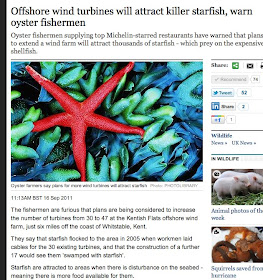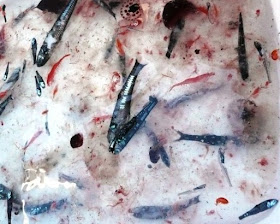
So, last week the UK newspaper-The Telegraph provided this interesting bit of news...
 one of the few times that sea stars have managed to get some front page coverage! The story has been picked up by a bunch of other news sites as you can see on Google...
one of the few times that sea stars have managed to get some front page coverage! The story has been picked up by a bunch of other news sites as you can see on Google...The quick and dirty version? There is a prominent offshore"wind farm" on the Kentish Flats, about 6 miles off the coast of Whitstable, Kent (this is on the Southeast coast of the UK). More on this here.
 There are plans to increase the number of these wind turbines (essentially big windmills) from 30 to 47.
There are plans to increase the number of these wind turbines (essentially big windmills) from 30 to 47.Fisherman are outraged! Why?
The article states that installation of these windmills riles up/disturbs the seabed and this apparently leads to areas that are "swamped with starfish" (presumably the predatory Asterias rubens).
This then leads to concern by the nearby coastal towns that these starfish will prey upon Whitstable's big cash "crop"... OYSTERS!
 One fisherman was quoted:
One fisherman was quoted:Studies show how wind farms attract starfish that eat oysters and if that happens they will wipe out most of the oyster population here and ruin our tourist industry.As much as I enjoy seeing press about my favorite animals, I also dislike some of the irrational hyperbole compounded by inaccuracies (and contradiction with science) that seems to infect "popular" articles.
Vattenfall (the company who oversees the windfarms) should have come to the fishermen of Whitstable and asked us what the least damaging place for the wind farm is.
I supply native oysters to 14 Michelin-starred restaurants every week. What will happen to my livelihood if I can no longer do that? It could wipe out our native industry and destroy Whitstable tourism in one hit.
My "take" here would be that the very acrimonious statements by the fishermen seem to come from the long-time enmity that has historically existed between oyster fisherman and the "common starfish" Asterias rubens which is one of the most evident predators of shellfish, such as oysters and mussels.
But the relationships among Asterias and other invertebrates in this ecosystem are MORE than the "killer starfish eat oysters" meme that the article tries to capitalize on..
But are the statements tilting at windmills??? (or windfarms as the case may be!)

Let's find out!!
Much of the data from this post comes from some classic work (1955!) by D.A. Hancock on the feeding behavior of "starfish on Essex oyster beds" that you can find here as a pdf. A nice abstract of the paper can be found here.
So, basically I've assembled 4 points that reflect, uh..lets say some "inaccuracies" in the article. And some information that might shed further light on the ecological players.
I'll caveat of course, that I have no data on the specific ecological case. I'm merely taking a lot of established information and presenting it, so that the more... hyperbolic conclusions... are put into a different context...
1. Asterias rubens is not the ONLY animal that feeds on oysters!
Probably one of the most inoccuous but damaging pests to European oysters is the introduced Oyster Drill, Urosalpinx cinerea. Some info on it here..but short version, each individual can devour about 40 oyster spat per YEAR.
These often leave a nice, neat little drilled hole in the shell.
 (from the Marine Biological Association site)
(from the Marine Biological Association site)Starfish like Asterias rubens feed by humping over the shell and waiting out or pulling open shellfish valves until they can get their stomachs inside the shell. No drilling or hard parts involved....

Another pest to oysters is the slipper shell-Crepidula fornicata. The "fornicata" part is so-called because alternating mating pairs are often attached to one another. More info on this species here.
Slipper shells aren't predators on oysters but they attach to oyster shells and are thought to be significant competitors for food and other resources that oysters like.

An important consideration here is that Asterias feeds on Crepidula--sometimes preferentially!
Hancock actually had this to say in 1955:
These also feed on Asterias!!
Hancock actually had this to say in 1955:
Only when Crepdiula is relatively scare and oysters occur in fair numbers will more oysters be killed. Under the present condition in the Essex rives, Asterias is by no means the most important cause of mortality among oysters and oyster spat; it may even provide some measure of control over the pests such as Crepidula, Balanus (a barnacle), Elminius, and even the fearsome of the fearsome oyster drill Urosalpinx and may therefore be considered as beneficial to the oyster population.And of course, there are OTHER starfish species, such as Crossaster papposus which can feed on small oysters and other shellfish.. but one important consideration??
These also feed on Asterias!!
 here's a picture of just these few players and how they interact...
here's a picture of just these few players and how they interact... Bear in mind that these are only SOME of the players. There are likely many more species at play.... Asterias feed on mussels also. I don't know which food source the local populations prefer, but you can spend years working on the ecology of a region like this..
Bear in mind that these are only SOME of the players. There are likely many more species at play.... Asterias feed on mussels also. I don't know which food source the local populations prefer, but you can spend years working on the ecology of a region like this..So, fishermen may visually SEE Asterias (or Crossaster) MOST frequently but probably not ALL of the influential animals that affect the oysters they prize so heavily..
Those little oyster drills probably do just as much (if not more?) to affect oyster crops as any starfish.
So, now you see more of the players...what about the game??
2. " and if that happens they will wipe out most of the oyster population here and ruin our tourist industry..." Do the starfish actually eat ALL of the OYSTERS like the fisherman guy was worried about??
So, let's maybe assume that somehow, all those other critters weren't POSSIBLY the cause of the oysters being eaten. Could Asterias by itself in a natural setting STILL be responsible?

This discussion assumes that Asterias rubens in its natural setting, where they interact with their native predators, competitors and environment.
If you introduce a predator like Asterias into an ecosystem, such as with Asterias amurensis in Australia where it has no natural predators or ecological relationships with prey (see this post and this one)-then uh..well, things can get out of hand..
But ecological theory has come quite a ways over the years and our understanding of how predators hunt (and how much energy is expended) leads to many considerations, such as....
- Will predators always pursue the prey to the very end?
- When do they "give up" before pursuing new prey?
- How much energy is expended on different kinds of prey?
- How does feeding on different prey structure the ecosystem in which the animal lives?
 (photo by Sue Scott, image from the MarLin Gallery!)
(photo by Sue Scott, image from the MarLin Gallery!)Several experiments with mussels and Asterias rubens in the Atlantic (such as this one by Norberg and Tedengren, 1995) do in fact show that starfish will "give up" on some mussels but not on others. What determines this is not clear-but it may involve variation of different species in different areas as well as shell shape, size and so on.
Other studies suggest that starfish such as Asterias or Pisaster affect the actual ecological structure of the areas in which they live. They devour mussels and/or other faunal members such as snail drills or barnacles that affect the amount of space that different animals settle onto.
This is the basis, in part of the keystone species concept, which I will get some other day...
So, they ARE important in affecting various mussels, oysters and what have you...
But will they eat up ALL the oysters just indescriminately? Nope.
They will likely devour many oysters-but its not even clear if Asterias will always (or even frequently) feed on the largest, showiest (and presumably most desirable for seafood market) oysters (which conceivably have stronger resistance to predation)....
One could argue that Asterias goes after weakened oysters or those with an optimal size for pulling open? Surprisingly, there is not nearly as much data on this as one would think..
3. So what COULD conceivably crash the oyster market in Whitstable, Kent??
There was no evidence in the Telegraph's account about why the fishermen might have been so concerned.. if the windfarms had truly led to an increase in starfish populations. But if you want to be worried about oysters?
This recent study indicates that oyster populations worldwide have plummeted indicating that up to 85% of oyster reef habitat has been lost.
The original paper (click here) shows the United Kingdom region as "Poor". But the overall reason for the decline seems to be due to multiple causes.. including harmful fishing practices, environmental abuse, and decline of environmental quality...
4. One final bit of picayune but thorough nitpicking....The starfish used in the article below?? Henricia sp. does NOT eat shellfish!

So, what we have here to me, seems to be a lot of overblown, hyperbolic fears, probably from years of perceived resentment that really, is probably kind of misplaced.
Instead of Don Quixote tilting at windmills, we have might more appropriately have Asterias' "Tilting at Starfish" (on windfarms)


















